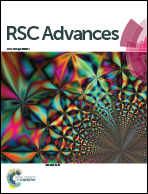Ion-pair recognition of amidinium salts by partially hydrogen-bonded heteroditopic cyclo[6]aramide†
Abstract
Convergent heteroditopic cyclo[6]aramide demonstrates efficient ion-pair recognition of amidinium salts in 10% methanolic chloroform (>104 M−1) as confirmed by NMR and conductivity experiments. As predicted by density functional theory (DFT) method simulations, cyclo[6]aramide 1a is able to bind amidinium salts G1–G5 with varying binding affinity in 1 : 1 stoichiometry through hydrogen bonding interactions involving both anion-recognizing amide H-atoms and cation-binding amide carbonyl O-atoms. Particularly, the binding affinities for G1, G2 and G3 are found to decrease with increasing the size of substituents in the amidinium ion in the order of G1 > G2 > G3. Moreover, the association ability for simultaneous binding of cationic and anionic guest species depends considerably on the counterions. Among the four formamidinium salts (Cl−, Br−, I− and BPh4−) examined, formamidinium chloride is best encapsulated as a contact ion-pair species in the macrocycle. The reduced association constants with increasing the size of counterions in the order of G1 > G6 > G7 > G4 underscore the importance of ion paring in effecting the host–guest interaction. Comparative conductivity studies provide a convenient approach to differentiate between contact and loose ion pairs for these amidinium complexes. This work provides a rare example of binding biologically important types of amidinium cations as ion pairs by a synthetic receptor.
![Graphical abstract: Ion-pair recognition of amidinium salts by partially hydrogen-bonded heteroditopic cyclo[6]aramide](/en/Image/Get?imageInfo.ImageType=GA&imageInfo.ImageIdentifier.ManuscriptID=C6RA08202E&imageInfo.ImageIdentifier.Year=2016)

 Please wait while we load your content...
Please wait while we load your content...